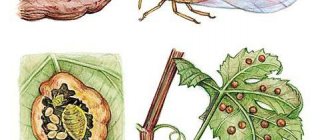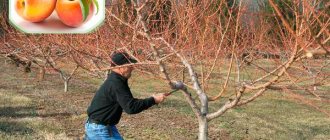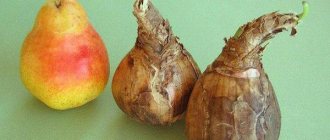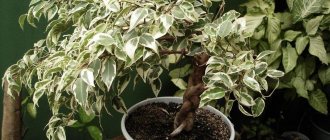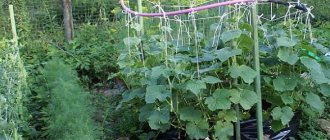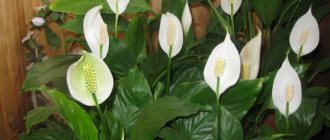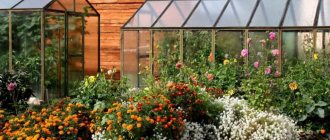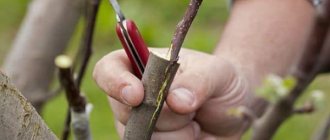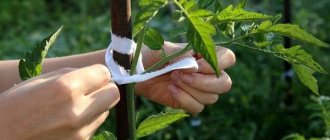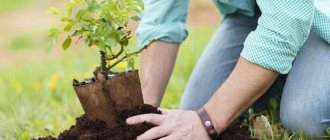Planting a peach in the fall may seem like a simple and easy procedure, but in reality it is not. The tree is very capricious and sensitive, and the approach of frost can be the main deterrent for farmers. But if you follow a few simple rules, the procedure for planting a peach tree in the fall will be easy and without any problems.
Benefits of planting peach trees in the fall
Many farmers claim that the ideal time to plant a peach tree is spring. Of course, if a tree is planted in the spring, over the summer and autumn it will take root well in the new place, settle in and take root, smoothly transitioning into winter hibernation. At the same time, the tree spends a lot of energy on new branches and growing greenery. As a result, the development of the root system slows down.
One of the main advantages of autumn planting of fruit crops is that during winter the seedlings do not suffer from diseases or insect attacks. The root system is well strengthened, and in the spring it quickly enters the growing season, the plant begins active growth and development.
But do not forget that if planted too late, the plant simply does not have time to adapt to the new location. As a result, with the onset of cold weather, it dies. That is why it is recommended to plant peach seedlings only in those regions where autumn is long and warm and winter is mild and short.
When the first frosts occur in October, planting should be abandoned.
How to plant a peach seedling correctly
Planting is the first and very important step that will give you a beautiful, fruit-bearing tree. In addition to direct planting, you also need to properly prepare the hole, choose a suitable place, seedling, and decide on the neighbors of the future tree.
Selection of seedlings
The first thing you should pay attention to when choosing a peach seedling is the variety. It must be suitable for a specific growing region and have winter hardiness (if cultivation is planned not in the southern regions).
For northern regions, it is recommended to choose early ripening varieties. When purchasing, try to find out the flowering time. If the tree blooms too early, late spring frosts can destroy the flowers.
Important! The variety must be suitable for your region.
For planting in the garden, you should choose a seedling that meets these requirements:
- The root system is well developed, has a main root and two or three lateral roots.
- The age of the seedling is no more than 2 years (ideally, its age should be 1.5 years).
- The optimal height is no more than one and a half meters.
- The seedling should not show any signs of damage.
- The bark is elastic, its integrity is not compromised.
- The seedling must be in the dormant stage without signs of vegetation.
- On the trunk of the future tree there should be a noticeable grafting site, indicating the grade of the tree. Also, the grafting site should have a slight bend, the site should be healed, without peeling off the bark.
Video: how to choose a fruit tree seedling.
Choosing a place in the garden
It is better to approach the choice of a place for a fruit tree responsibly. After all, the survival rate of the seedling and the harvest depend on comfortable conditions. To make the peach in the garden as comfortable as possible, you need to choose a place for planting that meets these criteria:
- It should be open and well lit by the sun.
- The tree should not lack light, so placing the seedling too close to other trees or buildings is excluded.
- This place should be sheltered from cold winds and drafts.
- It is optimal to choose a place near a fence that will protect the tree from freezing winds.
- Groundwater must lie at a level of at least three meters from the surface of the earth.
- It is better to plant on an elevated area.
Total : for a peach in the garden, a sunny, sheltered area, near a hedge on the south, southwest or west side, is suitable.
Soil selection
It is best to plant peach on loamy or chernozem soils that have a low acidity level . It is on these types of soil that it will be able to grow and bear fruit more safely.
It is not recommended to choose areas with clay and sandy soil . And if it is not possible to choose a place with favorable soil, then it is necessary to carry out some optimization measures:
- make good drainage using crushed stone or crushed brick;
- if the soil is clayey, add clean river sand to it;
- if the soil is sandy, then mix clay into it.
Preparing the planting hole
Experienced gardeners recommend starting to prepare the hole in the fall (if the event is planned in the spring), and if planting is planned in the fall, then it is better to start preparatory work in the spring or summer. Or at least 3-4 weeks before the event, regardless of the season. At the same time, when digging a planting hole, it is necessary to put the top fertile layer in one direction, and the bottom in the other.
Optimal dimensions of the planting hole : a diameter of about a meter (it should be twice the size of the root system), and a depth of about 60-70 centimeters (it should be three times the size of the root system).
It is recommended to add fertilizer to the bottom of the pit a month before the procedure . Thanks to this supply of nutrients, the seedling will be able to quickly take root and adapt after the event. It is recommended to apply fertilizers for the planting hole as follows:
- At the bottom there is a layer of humus.
- And a bucket of a mixture of fertile soil from the top layer of earth (1 bucket) + potassium fertilizers (100 grams) + phosphorus fertilizers (100 grams) is poured onto the layer of humus.
- Sprinkle the soil from the top layer on top so that the roots do not come into direct contact with the fertilizer and get burned.
Fertilizers should fill the hole by two-thirds. The applied fertilizer will have settled by the time of the autumn or spring procedure of the peach seedling, which will avoid voids.
Important! If the groundwater in your garden is high, then you must make a drainage layer at the bottom of the hole about 10 centimeters thick. You can use pebbles, crushed brick, crushed stone.
Video: how to prepare a planting hole.
Seedling preparation
Preparing a seedling helps it quickly take root in a new place and minimizes stress. Before the actual procedure, it is necessary to examine the seedling in detail and identify weak points. If you find damaged or rotten roots, they should be cut off.
Also, three hours before planting, you need to soak the roots in clean water. And right before planting, it is recommended to dip the roots of the plant in a mash of clay and mullein (it should have the consistency of sour cream).
Recommended distance between seedlings
An adult tree has a spreading crown. Therefore, immediately upon planting, you should choose the optimal distance between peaches.
There must be a gap of at least four meters between the trunks, and at least five meters between the rows.
The optimal distance between peach trees will help them grow safely and bear fruit normally.
Planting scheme
The procedure performed according to the recommended scheme will significantly increase the chances of success in growing and obtaining a future harvest. This step-by-step instruction will help you correctly plant a peach seedling in autumn or spring:
- Water the hole generously.
- Place the seedling in the center of the planting hole, being sure to straighten the roots. The root collar should be flush with the ground surface or 5 centimeters higher!
- Bury a wooden peg next to the seedling, which will initially serve as a support for the young tree.
- Fill the planting hole, avoiding voids between the roots.
- Gently compact the soil and secure the trunk of the seedling to the wooden support with soft twine.
- Form a circle around the trunk and water generously. Then shake the tree very slightly to eliminate voids in the ground.
- When the water is absorbed, loosen the soil around the tree and cover this area with a thick layer of mulch (you can use wood chips, peat, fallen leaves, straw).
Important! The grafting site of the seedling should be facing south.
Video: how to plant a peach seedling.
Ideal time to plant
Planting peach trees can only be done after they have gone into the dormant period. Select varieties that are ideal for growing in the climate specific to your area.
Dates for planting peach in autumn in different regions and countries
Around the period from September 5 to September 15, it is recommended to plant trees in the southern territories of Russia, including in the northwestern and northeastern parts of Ukraine. Also, timing this gives the tree enough time to establish roots before frost.
On the territory of the Krasnodar Territory, Crimea, the southern part of Ukraine, including Transcarpathia, it is recommended to land no later than October 20. If winter comes late, you can postpone planting to the first half of November, but not later.
In areas with a temperate climate, if the tree does not die in winter and survives frosts, it will most likely not bear fruit in the first year. However, this factor is greatly influenced by the regularity and correctness of care. Only those trees that grow in greenhouses and conservatories will definitely bear fruit.
Caring for peach tree sprouts
For a seedling to be strong, it needs not only proper planting, but also care. Compliance with agrotechnical standards will help reduce the likelihood of seedling death when transplanted into open ground. It is impossible to grow a good fruit-bearing tree without providing good conditions for the sprout. Young peach tree shoots need the following care at home:
- Illumination - it is recommended to maintain bright but diffuse lighting; a young plant needs 16-18 hours of daylight. It is recommended to supplement the seedlings with a phyto-lamp.
- Watering - overwatering should not be allowed; the soil should be moistened moderately - as the top layer dries.
- Fertilizing - it is recommended to apply it 2 times a month, you need to use nitrogen and potassium-phosphorus preparations in turn. It is permissible to fertilize with complex compounds that are diluted according to the instructions on the package.
- The substrate is air- and water-permeable, lightweight. A composition of peat mixture, sand, leaf turf, humus (1:1:2:1) is suitable.
- Temperature regime - in the winter season, the seedling is provided with a temperature of +2...+4˚ C, then it is gradually increased in the spring to +18˚ C, and in the summer it is maintained at about 25˚ C.
Transplantation of seedlings is carried out as they develop and the size of the plant increases. First, the flower container in which the seedling is planted should be small - no more than 0.5-1 liter. Afterwards, the container is replaced with a larger pot, the diameter of which is 0.5-1 liter larger. Transplantation is carried out before flowering in early to mid-March and in autumn, in the first days of September.
Selection of seedlings
The success of peach planting directly depends on the quality of the planting material. It is strictly forbidden to try to save on trees. To ensure that the seedling is of high quality and takes root after transplantation, you should use the following tips:
- Purchase planting material only from nurseries or experienced suppliers.
- Choose a variety that has been specifically bred to grow in a specific region.
- Carefully inspect the tree to ensure there is no damage.
- Trees 2 years old are ideal for planting.
- The height of the sprout should be about 1 m, thickness approximately 1.4-1.8 cm.
- The seedling should have 4-5 branches and full buds.
- Strong root. Do not buy seedlings with only one root, as they may not survive replanting.
- Do not take seedlings that show signs of root rot or wilted leaves.
- The green layer should be under the bark.
Buy trees before you plan to plant. During transportation, be sure to wrap the roots in damp burlap and wrap them in a layer of polyethylene. About 24 hours before you plan to plant, place the roots in water.
Experienced gardeners pour melted paraffin over the lower part of the tree trunk before planting. This measure will provide additional protection for the seedling from rodents, cold or sun.
Preparing the seeds
To obtain young and strong shoots from this crop, you should always take into account the peculiarities of growing peaches. For example, seeds obtained from store-bought fruits are not suitable for obtaining seedlings. The fact is that they are collected at the moment when the fruits barely begin to ripen. Therefore, the seed of such a peach will probably not have time to fully ripen.
The best option would be to choose the fruits you like on the market, as they say, from your own hands. Please note that if you buy peaches from the owner, he will probably tell you all the characteristics about the fruit-bearing tree, and also give recommendations on caring for the resulting planting material.
So, the peaches are bought and the seeds are taken out of the fruit. Naturally, the pressing question arises: what to do next? To begin, prepare the seed material. It is worth noting that regardless of how you plan to grow the crop in the future. In other words, whether peaches will grow in a greenhouse or in open ground, seed preparation is carried out in the same way, namely:
- the seeds are removed and washed thoroughly so that no pulp remains;
- then, the resulting seed material should be thoroughly dried at room temperature;
- further, carry out stratification;
- and just before planting, the seeds will need to be soaked in water.
Now it’s worth considering all the stages of preparing the seeds in more detail. Today there are many ways to get a strong and complete sprout from a seed. But below we will look at the simplest and most accessible method.
So, how to get a seedling:
- well-dried peach seeds are placed in the refrigerator for a week;
- after that they are planted in a pot with previously prepared soil to a depth of 7 cm;
- germination of the material is carried out in the light;
- the container where the seed was planted is covered with polyethylene or glass to create a greenhouse effect;
- Every day, the glass or polyethylene is removed for an hour to ventilate the pot and remove accumulated condensation.
Please note that this crop is moisture-loving, but it does not tolerate stagnant water. Therefore, before planting the seeds, make sure that small holes are made at the bottom of the pots to remove excess water.
Another important point to consider when planting peach pits. First of all, the soil must be nutritious so that the sprout can fully develop
It is also very important to regularly moisten the soil so that it does not dry out.
Choosing a location on the site
When choosing the right place to plant a peach, pay attention to the following recommendations:
- It is unacceptable to plant a tree in damp conditions and in areas where there are constant cold drafts. Peach tolerates heat and short periods of drought well.
- The southern part of the plot is perfect for planting peaches. It is important that shadows from other trees, a fence or a house do not fall on this area. Peach needs a lot of sun, as it begins to bloom earlier than other fruit crops.
- It is advisable that the tree be protected on the north side by a fence or wall. Provide enough free space, as the peach will grow and form a voluminous crown, so there should not be many trees nearby.
- Lowlands are not suitable, since it is in such areas that the soil becomes swamped and cool air is constantly present.
- Groundwater should not be too close to the surface - at least 1.3-1.6 m. A small hill or hill located in the south-eastern or eastern part is ideal.
- It is not recommended to plant a peach tree next to mature fruit crops that bear fruit for several seasons, because they will have a negative effect on the young shoot. The area where fruit trees used to grow is also not suitable, since their waste products and pests that can destroy a young peach may remain in the soil.
- Do not plant on soils where nightshades and melons grew. These plants can suffer from a variety of diseases that have a negative effect on the seedling or provoke the development of root rot.
Advantages and disadvantages of the reproduction method
Planting peaches from stones is not often done, since the overwhelming majority of amateur gardeners believe that only breeders and nursery workers are involved in this matter. However, it is not difficult to germinate peach pits if you strictly follow agrotechnical standards. This method of propagating a fruit-bearing crop has quite a lot of positive aspects, which are as follows:
- The peach whose pit will be sprouted has already been tasted and therefore the gardener knows what to expect from the future harvest.
- Proper propagation helps to obtain the number of plants required.
- The seedling turns out to be cheap, since there is no need to pay for someone to grow it.
- Own-rooted peach trees are a good basis for grafting.
How to care for a peach in the fall: preparing a peach for winter Peach is a plant zoned in southern countries.
Growing seedlings in the middle zone requires compliance... Despite all the advantages, in order to get a peach tree seedling, the gardener must be patient. The process of germination of peach pits is quite long. Also, the peach tree was originally a hybrid, which, although it was bred several centuries ago, cannot grow on its own in its natural environment. Because of this, the fruit plant is quite demanding to care for. When there is a strong desire to grow a peach from a pit, one must take into account not only the advantages of this process, but also its disadvantages, expressed in the following points:
- It is possible to obtain a tree whose fruits will taste similar to those of the mother plant only if it is grown from the seeds of non-hybrid varieties. The seeds of hybrids do not retain their characteristics.
- The sprout will only occur when the fruit is fully ripe, but fruits are sold for sale not fully ripe. They are removed before final maturity - when they reach technical maturity.
- If the planting material is from a heat-loving and demanding variety, then such a tree will not be able to grow in a more severe climate than Primorye, Krasnodar Territory or Crimea. Therefore, you should always carefully review the characteristics of the mother plant.
They take into account not only the heat-loving nature of the variety, but also other characteristics. For example, if the variety is pollinated, then there must be a peach tree nearby that blooms during the same period. If it is not there, and there is no desire to plant several copies of a garden crop, then choose self-fertile varieties of peach trees. Self-pollinating, not capricious, frost-resistant, fairly resistant to diseases and pests varieties with good yield include the following:
- Winter-hardy – can withstand down to -40˚ C, fruits weigh about 200 g, yield is high;
- Collins – tolerates down to -15˚ C, large-fruited, high-yielding;
- May flower - can withstand up to -20˚ C, fruit 130-140 g.
- Fluffy early - tolerates down to -28˚ C, good yield and others.
Attention! If you plan to grow a peach tree from a seed, even when its winter hardiness is increased, the plant still needs to be insulated for the cold season in harsh regions - in the Moscow region, the middle zone, the Leningrad region, and the Urals. In Siberia, it is recommended to grow fruit crops in greenhouses, but with good insulation it can also be grown in the garden.
Preparing the planting hole and soil
Prepare the site, starting with cleaning it - remove all stones and other debris, including fallen leaves, weed, removing remnants of roots and weeds. Do this about 2 months before the tree is supposed to be planted. Be sure to dig up the soil several times, as this simple procedure allows you to saturate the soil with oxygen.
It is recommended to sow the area in advance with grain crops or perennial grasses, adding various fertilizers to the ground. Do this several years before planting the peach. This procedure will allow you to fill the earth with valuable substances and minerals and eliminate various harmful elements from the decay of the vital activity of other plants.
If you plant peach on black soil, no additional fertilizer is required. In other cases, pour 2 buckets of rotted humus into the bottom of the planting hole, which you mix in advance with a small amount of black soil. You can also use this combination:
- rotted manure – 9 kg;
- potash fertilizers – 60 g;
- ammonium nitrate – 85 g;
- superphosphates – 145 g;
- the top layer of soil that was removed from the planting hole.
Then add a little tree ash and cover with a layer of black soil (at least 10 cm). Prepare holes for planting and leave for 10-14 days.
At what distance should I plant?
The peach grows tall and strong and has a spreading crown. That is why there must be sufficient distance between the trees so that they do not begin to interfere with each other.
During planting, make sure that the distance between the trees is at least 4 m, the distance between the rows is about 5 m. If you decide to ignore this rule, the neighboring trees will begin to oppress the peach and as a result it may completely die.
Planting hole depth
Prepare a hole measuring at least 0.5 m in width, depth and length. However, if the seedling is very large, the size of the recess can be increased.
To prevent moisture from stagnating in the ground in the future, be sure to place a drainage layer at the bottom of the hole - for example, use pebbles, expanded clay, brick, previously chopped into small pieces. But in this case, do not forget to increase the depth of the hole by 20-30 cm.
Features of further care
In the fall, before the first frost, the young tree must be covered. The roots and trunk of the plant are subject to insulation. Before cold weather, the tree trunk circle is covered with a layer of soil 20-30 cm thick. The top of the soil is covered with breathable material (burlap or agrofibre). The trunk is whitewashed with lime and protected from rodents with plastic cases or homemade structures.
Two ways to plant a peach
There are several ways to plant a peach tree. There are no special rules and you can choose any method that suits you best.
Plant on a cone
This is the easiest and most common way to plant fruit trees. It is enough to follow the following sequence of actions:
- Pour 2 buckets of plain water into the prepared pit;
- when the liquid is absorbed into the ground, add fertilizer to the bottom;
- Place a seedling on the top of the formed mound, straighten the roots along the slope so that they are at an angle of approximately 45 degrees;
- fill the hole with earth and compact it a little;
- make sure that there are no air cavities near the roots;
- water the tree with 1 bucket of plain water;
- when water is absorbed into the ground, mulch the area near the trunk with peat, humus, and crushed bark;
- fix the seedling near the support so that it does not tilt during soil settlement after planting.
Watch the following video about planting a peach using the “cone” method:
Plant "in the slurry"
Using this method allows you to plant a peach yourself, without additional help. Need to do:
- Add humus (2-2.5 buckets) to the bottom of the planting hole and pour plain water (1-1.5 buckets);
- after half the water has flowed into the ground, add fruit soil (1 bucket);
- a slurry should form into which the tree root is placed;
- the viscous substance independently holds the peach in the desired position;
- Gradually fill the hole with soil and periodically pull the seedling up, which will align the roots in the correct position;
- after filling the hole, water the tree again;
- mulch the tree trunk circle - the thickness of the mulch layer is at least 6 cm.
In the video below, the gardener provides an overview of planting peach in the fall using the “in the slurry” method:
Peach orchard planting scheme
Planting a peach requires two people. The procedure is carried out using the following technology:
- At the bottom of the hole, a hill is formed from the prepared soil mixture, into the center of which a wooden stake is driven in as a support for the future seedling.
- A small layer of garden soil without organic and mineral additives is poured on top of the hill. The same soil will be used to fill the hole.
- The seedling is placed on a hill next to the support, the roots are carefully distributed on different sides.
- While one person holds the tree in a strictly vertical position, the other begins to cover the hole with soil layer by layer, periodically compacting the soil so that there are no voids left inside. You need to fill the hole until the root collar is buried 5–7 cm into the ground.
- At the end of the procedure, the earth is compacted tightly again, a low earthen rampart is formed around the circumference and watered generously with slightly warmed water.
- Then the seedling is tied to a support using twine or other soft material that cannot scratch the delicate bark.
- When the water is absorbed, the tree trunk circle is generously mulched with peat, sawdust, rotted manure or fallen leaves of non-fruit trees. Straw is not suitable as mulch because it attracts mice, hares and other rodents to the area (especially in winter), which often gnaw the bark of young trees.
Video: planting a peach seedling
Possible mistakes when planting peach
During the peach tree planting procedure, the following mistakes are most often made:
- Too much mineral fertilizer was added to the planting hole. This leads to the death of beneficial bacteria that process fertilizers into a form that can be absorbed by the plant.
- If the hole for planting has not been prepared in advance, this leads to the root collar becoming too deep. After planting, the soil will settle too much. As a result, the proper development of the tree slows down.
- It is important to choose the right peach variety that is suitable for growing in a certain climatic zone. In the future, such a discrepancy may cause the death of the plant.
- Incorrect timing for planting a seedling leads to its death.
- Planting a seedling that is more than 2 years old. As a result, the peach in a new place will take a long time to take root, which negatively affects the development process.
Varieties of peaches
The varieties of peaches presented below are suitable for growing in the Moscow region and other regions of the country.
Golden Jubilee
The Golden Jubilee peach variety was developed in America in 1921, after which it quickly spread throughout the world. The tree reaches a height of 2.5 m, has a spreading crown and abundant branching.
The fruits are small, the average weight of one fruit is 0.14–0.17 kg, extremely rarely the weight of the fruit is 200 g.
Advantages of the variety:
- early fruiting - the first harvest can be harvested 3-4 years after planting;
- high yield - up to 40 kg of fruits can be collected from one tree (sometimes up to 60 kg;
- good winter hardiness - the tree can easily withstand temperatures down to minus 25 degrees;
- rare infection by fungal diseases;
- attractive presentation.
Flaws:
- despite good winter hardiness, in the middle regions it is recommended to insulate peach for the winter;
- in the northern regions, the crop is likely to freeze in the first winter;
- poor transportability;
- demanding care;
- tendency to fruit shedding.
The ripening of the Golden Jubilee falls in early August, depending on the region. In the middle regions, the fruits ripen closer to mid-August. It is not recommended to keep fruits on the tree, otherwise they will fall off.
Donetsk yellow
Self-fertile peach variety Donetsk yellow, late ripening; the first harvest can be harvested 2–3 years after planting. The weight of one fruit is 0.13–0.18 kg. The fruits ripen after August 20.
Donetsk yellow has average resistance to diseases and tolerates cold well.
Fluffy early
This is a domestic peach variety that was bred in 1932. Easily tolerates frosts down to minus 30 degrees, suitable for growing in the Moscow region. The round, cream-colored fruits ripen by mid-July. This peach variety is great for making preserves, jams and eating fresh.
Juicy
An early frost-resistant variety, the tree can withstand temperatures down to minus 30 degrees. Resistant to powdery mildew, rarely susceptible to leaf curl.
The advantages of Juicy include high yield, but sometimes it is necessary to pick unripe fruits to prevent branches from breaking off. The weight of one fruit is 0.13 kg.
Memory of Simirenko
The variety Memory Simirenko was bred in 1987. It is a hybrid of 4 different varieties: Golden Age, Rochester, Rot Front, Art Beauty. This is an early variety of peach and begins to bloom in mid-April.
Simirenko’s memory calmly tolerates temperatures down to minus 30 degrees. It is extremely rarely affected by disease. Gives a good and stable harvest throughout its life. With proper care, it begins to bear fruit in the 4th year. The weight of the fruit is 0.1 kg.
Redhaven
This peach variety was developed in America in 1940. The tree reaches 5 m in height, has a spherical and not very dense crown with large flowers. The weight of the fetus is 0.12–0.2 kg. The fruits begin to ripen at the end of July. The harvest lasts for a month, since not all fruits ripen at the same time. Already from the 6th year, Redhaven begins to produce a stable harvest; 35–40 kg of fruit can be collected per season. In the 11th–12th year of a tree’s life, the yield doubles; 100 kg of fruit can be harvested per season.
Peach adapts well to night temperatures of at least 15 degrees Celsius.
Care after disembarkation
The peach tree is very sensitive, and in order for it to take root safely in a new place, it requires proper and constant care. The future harvest depends on how correctly watering is carried out, fertilizers are applied and preparations for winter are carried out.
Watering
In the first year after planting, the tree needs regular and abundant watering. One adult plant requires approximately 50 liters of water. In hot and dry summers, more frequent watering is required.
Always monitor the condition of the soil, as too intense watering and stagnation of moisture can cause the death of the plant. About 10 days before the fruits are fully ripened, stop watering. In dry weather, sprinkle the crown.
In addition to watering, regularly remove weeds and loosen the soil. Mulch the soil using straw and sawdust. It is better not to use fallen dry leaves for this purpose, as pests can live in them.
Fertilizer
Starting from the second year of the tree’s life, fertilize three times per season. Use nitrogen fertilizers in the spring. In summer and autumn, phosphorus and potassium are suitable for feeding.
Trimming
Carry out sanitary pruning along with formative pruning in the spring, when the winter shelter is removed. On a young tree, remove all excess ovaries, otherwise an excessive amount of fruit will lead to breakage of the branches.
Carry out pruning with the onset of autumn - leave no more than 4 shoots on the bottom of the trunk. This procedure will allow you to properly prepare the plant for the winter.
Sheltering a seedling for the winter
Be sure to cover the young tree before winter. If the peach is small, tie the branches and bend them to the ground. Cover the top of the tree with special material. In the spring, when the frosts have passed, remove the cover.
Protecting the peach tree from diseases and pests
Many peach varieties are characterized by excellent resistance not only to diseases, but also to various pests. But in early spring, it is recommended to take preventive measures:
- when you remove the shelter, treat the tree with a solution of Bordeaux mixture 3%;
- when the ovaries are formed, treat with fungicides;
- Whitewashing the peach trunk with lime in the spring is an effective prevention.
Autumn planting of peach in your own garden requires increased attention and proper care from the gardener. This plant is quite capricious and requires compliance with certain rules, neglect of which can lead to a poor harvest or complete death of the plant.
0
0
Copy link
Choose a place and determine the neighborhood
Before planting, be sure to find out which trees can be planted with peach. This will make the process of choosing a growing area easier. An incorrectly chosen neighborhood will weaken the immune system.
Important! When choosing what to plant next to, you need to take into account that the worst neighbors are pear, cherry, walnut, apricot, and sweet cherry.
The tree loves warmth and an abundance of sunlight. The plant is capricious, heat-loving. Transplantation of the appendix is undesirable, so the choice of location must be approached responsibly. The best place is the south side of the site. The plant should not be exposed to shadows from other plantings. It needs a lot of light and begins to bloom earlier than others. It is advisable that the tree be protected by a fence on the north side. This will protect the plant from strong winds.
You cannot plant a tree in a lowland. There is a high probability of soil waterlogging there. Peach planting rules recommend planting the plant on a hillside. It will develop quickly and bear fruit successfully. Peach seedlings should be planted away from old trees. Mature plantings will take strength from young plants. The peach orchard planting scheme will help you do everything right.
An area cleared of old plantings is also not suitable for placement. Harmful waste products are stored there. The area where nightshades used to grow is not suitable. The distance between trees should be at least 2.5 meters. Plantings should not interfere with each other. Also, the distance between plantings depends on the age of the trees. When located near an old planting, the indentation should be at least 3 meters. Productivity also depends on the soil. The best option is black soil or light loam.
Pruning and shaping the peach crown
In order for a peach to produce a high yield, its crown must be correctly formed. To do this, trim it. Since peach is a light-loving plant, pruning it allows you to form a well-lit, bowl-shaped tree shape.
Spring pruning of peach should be carried out in early March at a positive air temperature of at least +5 degrees, regardless of the time of day. If the winter was very frosty, then experts recommend postponing this procedure until the beginning of the growing season in order to accurately determine the degree of frostbite of the shoots and the level of pruning. The more damaged the peach, the less it is worth pruning so as not to weaken the tree’s immunity.
The cup-shaped crown lacks a central conductor. These are three or four skeletal branches that emerge from the bottom of the tree. Already in the spring after planting, they are planted. The peach seedling is pruned at a height of 80 cm, leaving approximately 20 cm for the skeletal branches and 60 cm for the trunk. If the tree has side branches, then only three or four strong shoots are left, cutting them to 15 cm in length. Subsequently, skeletal branches will form from these stems. Weak shoots are simply shortened, leaving two or three buds.
The remaining branches are cut off along with the conductor. In summer, it is necessary to monitor the shape of the tree and break out vertically growing shoots. The next year, the skeletal branches embedded in the peach crown are cut so that they are the same length. And from the emerging stems, two buds are formed, from which new shoots later appear. The shoots that grow in summer on skeletal branches and trunks are removed, leaving up to 10 cm. Pruning peach prevents the thickening of the crown.
In the third year, strong shoots are selected, located at a distance of half a meter from the base of the skeletal branches, they are shortened to 50 cm. These are additional secondary shoots. After another year, branches of the third order are laid and shoots growing downwards are removed. Only in the fifth year does peach pruning help shape the crown by laying down skeletal branches.
Anti-aging pruning. Depending on the plant variety, the fruiting period lasts only 10-12 years. However, the tree's yield can be extended through rejuvenating pruning. First of all, the tree is inspected, since it must have a healthy trunk and lower skeletal branches. Only then does peach pruning occur.
How it's done? First, remove all dried branches. They are cut off near young shoots, which in the future will be the main shoots. A sick tree is not rejuvenated; it is pruned without any rules in order to obtain a high yield for some time.
Carrying out the procedure annually helps to form the crown of young seedlings and rejuvenate old trees. Pruning peach helps to redistribute nutrients, maintain a balance between the crown and root system, and also allows you to significantly speed up the fruiting process and creates convenience during harvesting.
Peach pruning in autumn
In the autumn, you need to start preparing the peach for wintering. Carefully cut off all dried, injured, old and disease-damaged fruit branches, as well as those growing inside the crown and contributing to its thickening. Only completely healthy branches and stems should remain on the plant, which will bear fruit in the next season. In autumn, crown formation is not done.
In the summer, fruit-bearing trees are pruned only when absolutely necessary.
Diseases, pests and their control
The peach does not have many enemies, but they are all caused by fungi and are very serious. It is impossible to grow a full-fledged tree without prevention:
- Leaf curl . To combat it and for prevention purposes, Bordeaux mixture (3% solution) is used. The first time is sprayed in the spring, while there are no buds, the second time after harvesting the fruits, the third time after the leaves fall. In case of severe infection, use the drug Horus.
- Moniliosis. It appears when the weather is damp during flowering. The flowers turn brown, the ovary falls off. The peach is sprayed with Bordeaux mixture in the spring, when there are no leaves on it. If a tree is infected with spores in large quantities, then diseased branches and shoots must be cut out and destroyed.
Manifestation of powdery mildew
- Powdery mildew manifests itself through deformed leaves and a white coating on all parts of the tree. To fight, the same Bordeaux mixture and colloidal sulfur (1% solution) are used. Infected shoots are removed.
Pests that have settled in the bark are destroyed by treating the trunk with lime and a small amount of copper sulfate.
Growing a peach is not an easy task; without constant attention, you are unlikely to get a good result, but if everything is done correctly, the tree will regularly delight you with a bountiful harvest.
Features of growing peach: video
How to grow a peach: photo
Peach propagation in the country
Peaches in the country are propagated by grafted seedlings purchased from appropriate companies and seeds.
Moreover, the second is the most common technique, which does not require complex manipulations during planting and growing seedlings. Seed propagation of peach is advantageous in that the trees grow more resistant to the vagaries of weather and diseases. When propagated by seed, not all planted seeds can form a crop with maternal characteristics. The ovary in peaches is formed as a result of cross-pollination, and some of the seeds may bear characteristics of the rootstock. To reduce selection error, you need to sow a large number of seeds. When the first leaves appear on the seedlings, those with a wider leaf blade should be selected. Of course, this is not 100% reliable, but there is still a possibility of selection. When sowing in pots, not just one peach seed is sown, but 3-4, and after germination, 1 strongest seedling is left, and the rest are cut off at the soil surface.
Peach seeds are sown in open ground in the southern regions from October 15 to November 10-15. The bones are first scarified or soaked for 2-3 days in warm water, which is changed daily. For planting seeds, zoned varieties of peaches are chosen, which is especially important in the middle zone. Seeds of such varieties will guarantee a crop that forms a harvest and is resistant to climatic conditions. Under cover, plants will freeze less. Imported varieties that are not adapted to our climate may turn out to be barren or freeze out in the first winter. In order for peaches to successfully develop and form a high-quality harvest, it is necessary to comply with the requirements of agricultural technology and cover the crop during the cold period.
For the schoolchild, choose a sunny place, fertilize the soil with humus or mature compost. Peach seeds are placed in holes to a depth of 6-8 cm. The holes are placed at a distance of 7-10 cm. During the winter, the seed undergoes natural stratification, and seedlings appear in the spring. Peach seedlings grow quickly, but require careful care. The soil should be loose, weed-free, and constantly moist (not wet). During the summer season, 3-4 feedings are carried out, preferably with Kemira or Crystallon at a rate of 30-40 g/sq.m. m.
When growing peach seedlings at home, after sowing the seeds, the containers are placed in a warm place, which is equipped according to the principle of a mini-greenhouse. Before germination, the temperature in the room is maintained at +10..+15°C, and after germination it is gradually raised to +18..+20°C. The soil should be constantly moist. When seedlings emerge, containers with seedlings must be placed in well-lit places. Planting of peach seedlings in open or closed ground is carried out in the spring by transshipment method at a soil temperature in the root layer not lower than +12..+14°C with a constant high air temperature.
How to care after the event
After planting in open ground, a peach seedling needs especially careful care for the first two years.
At first, he will need strength to adapt to new conditions and settle down in a new place. And our task is to help him with this, especially if the landing took place in the middle zone, in Siberia, in the Urals. Below you will find instructions that will help you properly care after planting in the fall and spring.
Care after autumn planting
Caring for a young tree after planting in the fall includes the following activities:
- Trimming. After planting the peach in the fall, pruning is carried out. It is necessary to form the tree in the form of a bowl (this type of crown is characterized by a small trunk size, with skeletal branches growing close to the surface of the ground). From the grafting site to the first developed side shoot, it is necessary to measure a segment of 35 centimeters. And then you should cut the branches above this segment into a ring, leaving three to five most developed shoots, they should be directed in different directions and there should be a distance of at least 10-15 centimeters between them. The remaining branches are cut to three buds from the base. The seedling itself is pruned at a height of 80 centimeters.
- Protection from rodents and pests. If your site is often attacked by rodents (for example, mice, hares, etc.) and pests, then you should definitely protect the young tree. It is necessary to mulch the tree trunk circle, and also protect the trunk with some material, for example, a plastic bottle, spunbond, roofing felt.
- Mulching. Even if pests and rodents do not come to you, you still need to insulate the tree trunk circle with a thick layer of mulch. It will protect the young peach from cold and bad weather. Sawdust, peat, humus, hay, etc. can be used as mulching material.
- Shelter. After planting in the fall, it is necessary to provide shelter, since the crop is heat-loving and frost is dangerous for it. For example, you can wrap the trunk with dense agrofibre.
Care after spring planting
It is necessary to care for a peach seedling after spring planting as follows:
- Watering. In the first stages, the soil should not be allowed to dry out; it is optimal to water the tree once every 7 days, the volume of water should be at least four buckets. At the same time, moisture stagnation should not be allowed. In the future, watering can be reduced to once every 10-14 days.
- Weed removal and loosening. Regularly remove weeds around the tree and loosen the soil around the tree trunk after watering.
- Pest and disease control. Regularly monitor the condition of the tree; if pests or signs of disease are found, you need to treat it with insecticidal and fungicidal preparations.
- Mulching. Just like in the fall, in the spring you need to put mulching material around the tree.
- Trimming. After planting in the spring, pruning is carried out according to the same pattern as in the fall.
This crop grows quite quickly, especially if the planting was done correctly and the plant grows in comfortable conditions and receives proper care. So it’s in your hands to ensure yourself a rich and tasty harvest of peaches.

